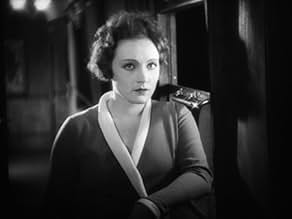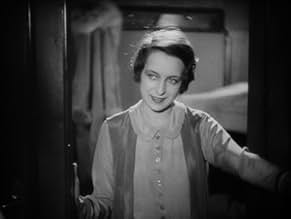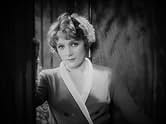VALUTAZIONE IMDb
6,7/10
330
LA TUA VALUTAZIONE
In luna di miele, un uomo si innamora di una donna che è nelle grinfie di un personaggio sinistro. Dopo che questa donna lo prega di aiutarla a scappare, complotta per farlo sfruttando l'occ... Leggi tuttoIn luna di miele, un uomo si innamora di una donna che è nelle grinfie di un personaggio sinistro. Dopo che questa donna lo prega di aiutarla a scappare, complotta per farlo sfruttando l'occasione di un ballo in maschera.In luna di miele, un uomo si innamora di una donna che è nelle grinfie di un personaggio sinistro. Dopo che questa donna lo prega di aiutarla a scappare, complotta per farlo sfruttando l'occasione di un ballo in maschera.
- Regia
- Sceneggiatura
- Star
Recensioni in evidenza
Henri Leblanc ( Herr Uno Henning ), descendant of a bankrupted Industrialist family, marries a rich heiress in order to save the family firm. On the honeymoon, Herr Leblanc meets a mysterious woman on the train, Frau Stascha ( Frau Marlene Dietrich ) with whom he will fall desperately in love. He goes to ruin with her, leaving his wife on the train and fleeing with Frau Stascha to Cannes.
But Stascha, bound to Dr. Karoff ( Herr Fritz Korner ), especially needs the protection of Herr Leblanc due that fact that her relation with the Dr. is connected with the knowledge of a crime.
"Die Frau, Nach Der Man Sich Sehnt" (1929) ( "Three Loves" ), a film directed by Herr Curtis Bernhardt, it is a very remarkable oeuvre and certainly the best silent film made by Frau Marlene Dietrich.
Before this excellent film, Frau Dietrich was a cute and plump fraulein that had a not very impressive career in roles directed by different and sometimes important German directors. That's until Herr Bernhardt takes advantage of all of her true possibilities for the silent screen emphasizing those same traits that later Herr von Sternberg uses in a similar way for the sake and glory of Frau Dietrich.
At this point it is necessary for this German count to say that the work that Herr von Sternberg did with his most outstanding pupil wasn't at all entirely original and exclusive as evidenced in "Die Frau, Nach ", Herr Bernhardt did splendid work in the same artistic and dramatic parameters which, in turn, Herr Dietrich enhanced in the special atmosphere of the silent screen. In years later, it was for Herr von Sternberg to enlarge the talkie career of the Teutonic actress.
The great cinematography by the reputable Herr Curt Courant und Herr Hans Scheib, created those classic sculptured face shots of the actress amid shadows and enigmatic angles creating the paradigm of a "femme fatale". This shines especially in this mysterious love triangle drama. Thus results an "amour fou", perfectly developed in different sceneries with everything for the sake of Frau Dietrich. The film is an unconditional gift and a perfect vehicle for the Teutonic actress that certainly owes a lot to this film's construction in a manner that later became her personal and well-known iconic image.
But not only Frau Dietrich deserves attention in this film; the male main characters of the picture ( Herr Fritz Korner und Herr Uno Henning ) did excellent work too as two tormented lovers whose fascination and infatuation for Frau Stascha will bring them only misery and a doomed life.
The film transits between different sceneries. There are segments of the film that are very well defined and in continuity, developing the increasing passion and dramatism that brings the main characters of the film to life. These start with the industrialist images of the first part of the picture ( in those days, Germans liked a lot scenes of engines, pistons and steam ) which are mechanical, emotionless and symbolic of Herr Leblanc's marriage of convenience. They continue to the uncontrolled passion that Herr Leblanc will experience in the train when he meets Frau Stascha via visualizing an era when the train was a romantic and unpredictable mean of transport... and had nothing in common with the aseptic and fast high-speed trains of nowadays. And at the party at the hotel during the night of the Holy Sylvester, the facts accelerate to the end of this peculiar tragic love triangle via a "in crescendo" film story in which the eroticism, drama and wild passion are depicted in a very remarkable and fascinating way.
"Die Frau, Nach Der Man Sich Sehnt" is an outstanding silent film that depicts one of those mad love stories than only can happen in silent films and confirms that Frau Dietrich already existed and was "invented" by Herr Bernhardt years before Herr von Sternberg.
And now, if you'll allow me, I must temporarily take my leave because this German Count must talk with Frau Dietrich about old German times.
But Stascha, bound to Dr. Karoff ( Herr Fritz Korner ), especially needs the protection of Herr Leblanc due that fact that her relation with the Dr. is connected with the knowledge of a crime.
"Die Frau, Nach Der Man Sich Sehnt" (1929) ( "Three Loves" ), a film directed by Herr Curtis Bernhardt, it is a very remarkable oeuvre and certainly the best silent film made by Frau Marlene Dietrich.
Before this excellent film, Frau Dietrich was a cute and plump fraulein that had a not very impressive career in roles directed by different and sometimes important German directors. That's until Herr Bernhardt takes advantage of all of her true possibilities for the silent screen emphasizing those same traits that later Herr von Sternberg uses in a similar way for the sake and glory of Frau Dietrich.
At this point it is necessary for this German count to say that the work that Herr von Sternberg did with his most outstanding pupil wasn't at all entirely original and exclusive as evidenced in "Die Frau, Nach ", Herr Bernhardt did splendid work in the same artistic and dramatic parameters which, in turn, Herr Dietrich enhanced in the special atmosphere of the silent screen. In years later, it was for Herr von Sternberg to enlarge the talkie career of the Teutonic actress.
The great cinematography by the reputable Herr Curt Courant und Herr Hans Scheib, created those classic sculptured face shots of the actress amid shadows and enigmatic angles creating the paradigm of a "femme fatale". This shines especially in this mysterious love triangle drama. Thus results an "amour fou", perfectly developed in different sceneries with everything for the sake of Frau Dietrich. The film is an unconditional gift and a perfect vehicle for the Teutonic actress that certainly owes a lot to this film's construction in a manner that later became her personal and well-known iconic image.
But not only Frau Dietrich deserves attention in this film; the male main characters of the picture ( Herr Fritz Korner und Herr Uno Henning ) did excellent work too as two tormented lovers whose fascination and infatuation for Frau Stascha will bring them only misery and a doomed life.
The film transits between different sceneries. There are segments of the film that are very well defined and in continuity, developing the increasing passion and dramatism that brings the main characters of the film to life. These start with the industrialist images of the first part of the picture ( in those days, Germans liked a lot scenes of engines, pistons and steam ) which are mechanical, emotionless and symbolic of Herr Leblanc's marriage of convenience. They continue to the uncontrolled passion that Herr Leblanc will experience in the train when he meets Frau Stascha via visualizing an era when the train was a romantic and unpredictable mean of transport... and had nothing in common with the aseptic and fast high-speed trains of nowadays. And at the party at the hotel during the night of the Holy Sylvester, the facts accelerate to the end of this peculiar tragic love triangle via a "in crescendo" film story in which the eroticism, drama and wild passion are depicted in a very remarkable and fascinating way.
"Die Frau, Nach Der Man Sich Sehnt" is an outstanding silent film that depicts one of those mad love stories than only can happen in silent films and confirms that Frau Dietrich already existed and was "invented" by Herr Bernhardt years before Herr von Sternberg.
And now, if you'll allow me, I must temporarily take my leave because this German Count must talk with Frau Dietrich about old German times.
The Marlene Dietrich we all know was not created out of whole cloth by Josef von Sternberg; he simply refined the superlative raw material that was already there. And this film proves the point. As soon as Dietrich appears in this late silent melodrama the film belongs to her and stays that way despite excellent performances from strong actors such as Uno Hemming and Fritz Kortner. The story is about the heir to an ironworks fortune (Hemming, who looks like a cross between a young Laurence Olivier and Mel Ferrer), who, on the way to his honeymoon with a woman he doesn't love, locks eyes with Dietrich who is in a similar predicament (with Kortner). From that point the film is occupied with the ensuing love triangle.
The principals all end up at a mountain ski resort where events build to a climax during a New Year's Eve celebration, complete with streamers, balloons, masked revelers and confetti strangely reminiscent of key scenes in two later Dietrich-von Sternberg films, "Dishonored" and "The Devil Is a Woman," making one wonder if von Sternberg saw this film, liked the party scene and strove to improve upon it.
Dietrich is indeed on the plump side (as she was in "The Blue Angel"), but aside from such superficialities as extra pounds, fuller face and frizzy hair there is no significant difference between her effect here and in later Hollywood films. The allure is the same. It must be said that director Curtis Bernhardt makes a point of lingering over her shapely legs in a way that von Sternberg might have considered vulgar.
The principals all end up at a mountain ski resort where events build to a climax during a New Year's Eve celebration, complete with streamers, balloons, masked revelers and confetti strangely reminiscent of key scenes in two later Dietrich-von Sternberg films, "Dishonored" and "The Devil Is a Woman," making one wonder if von Sternberg saw this film, liked the party scene and strove to improve upon it.
Dietrich is indeed on the plump side (as she was in "The Blue Angel"), but aside from such superficialities as extra pounds, fuller face and frizzy hair there is no significant difference between her effect here and in later Hollywood films. The allure is the same. It must be said that director Curtis Bernhardt makes a point of lingering over her shapely legs in a way that von Sternberg might have considered vulgar.
Marlene Dietrich maintained that when Joseph von Sternberg 'discovered' her she was a virtual unknown but like so many of her utterances this has to be taken with a barrelful of salt. She had already attracted attention in 'I kiss your hand, Madame' and after seeing her onstage in Shaw's 'Misalliance', director Kurt Bernhardt was so impressed by her charisma that he cast her as what was to be the first of her trademark 'femme fatales' in this loose adaptation by Ladislaus Vajda of the novel by Max Brod.
One is usually on to a good thing with films from the Weimar period and Bernhardt's fluid, modern direction here transcends the melodramatic material. This is a strikingly made film the highlight of which is the New Year's Eve party which is a veritable tour de force thanks to rapid cutting and Curt Courant's virtuosic camerawork. It is not unusual for music specially composed for silent film restorations to be disappointing if not downright irritating but Pascal Schumacher's magnificent score is a glorious exception.
Dietrich has star quality in spades and is perfectly complemented by Swedish actor Ugo Henning as the poor sap who is putty in her hands and the excellent Fritz Kortner whose Dr. Karoff is by turns suave and sinister.
Although von Sternberg is credited with being Dietrich's Svengali, one should not underestimate Bernhardt's contribution for she is pretty well formed in this and as a screen personality brought rather more to von Sternberg than is generally acknowledged.
One is usually on to a good thing with films from the Weimar period and Bernhardt's fluid, modern direction here transcends the melodramatic material. This is a strikingly made film the highlight of which is the New Year's Eve party which is a veritable tour de force thanks to rapid cutting and Curt Courant's virtuosic camerawork. It is not unusual for music specially composed for silent film restorations to be disappointing if not downright irritating but Pascal Schumacher's magnificent score is a glorious exception.
Dietrich has star quality in spades and is perfectly complemented by Swedish actor Ugo Henning as the poor sap who is putty in her hands and the excellent Fritz Kortner whose Dr. Karoff is by turns suave and sinister.
Although von Sternberg is credited with being Dietrich's Svengali, one should not underestimate Bernhardt's contribution for she is pretty well formed in this and as a screen personality brought rather more to von Sternberg than is generally acknowledged.
Lo sapevi?
- BlooperThe train is a clumsy model, and behaves like one, in particular stopping on a dime the moment the communication cord is pulled.
- Versioni alternativeThere is an Italian edition of this film on DVD, distributed by DNA srl, "LA CONTESSA ALESSANDRA (L'ultimo treno da Mosca, 1937) + ENIGMA (1929)" (2 Films on a single DVD), re-edited with the contribution of film historian Riccardo Cusin. This version is also available for streaming on some platforms.
- ConnessioniFeatured in Marlene Dietrich: Shadow and Light (1996)
- Colonne sonoreBist du das Glück, nach dem ich mich gesehnt
Written by Giuseppe Becce
I più visti
Accedi per valutare e creare un elenco di titoli salvati per ottenere consigli personalizzati
Dettagli
- Tempo di esecuzione
- 1h 16min(76 min)
- Colore
- Mix di suoni
- Proporzioni
- 1.33 : 1
Contribuisci a questa pagina
Suggerisci una modifica o aggiungi i contenuti mancanti
























